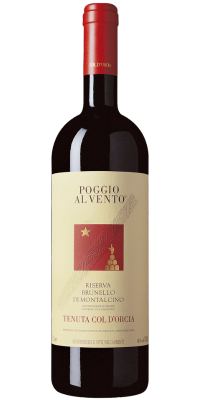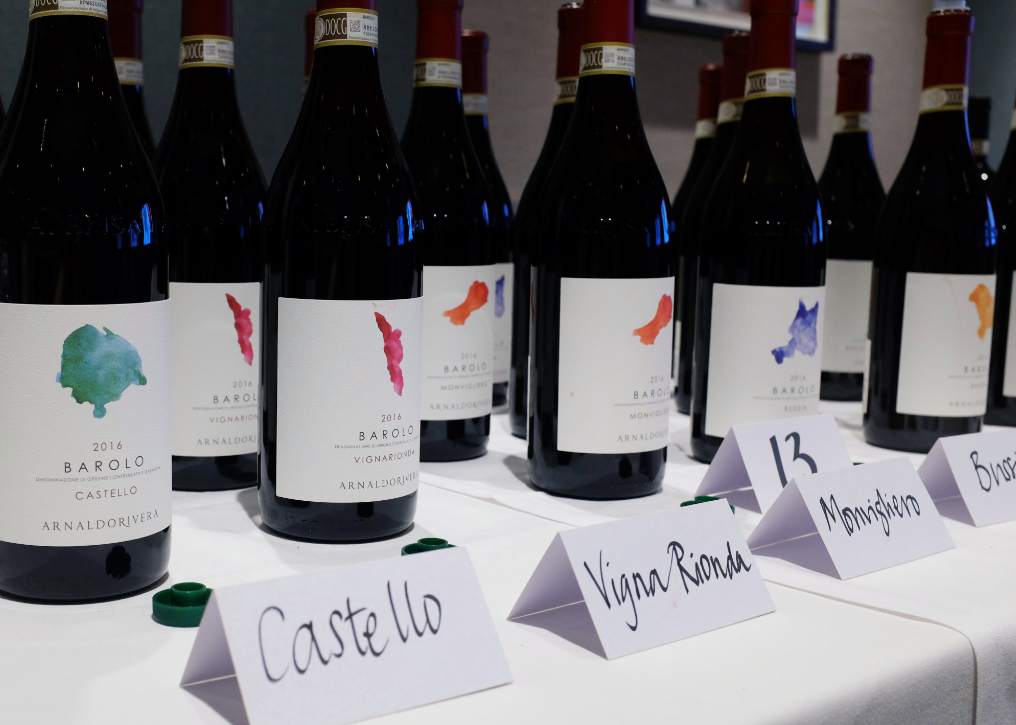Late released:
2004, 2001 plus 2015 Brunello di Montalcino Riserva, Poggio Al Vento, Col d’Orcia
Direct from the estate
2004 Poggio al Vento, Brunello di Montalcino Riserva - £840 per 6 bottle case in bond
2001 Poggio al Vento, Brunello di Montalcino Riserva - £840 per 6 bottle case in bond
2015 Poggio al Vento, Brunello di Montalcino Riserva - £550 per 6 bottle case in bond
In terms of quality and value, there was one frontrunner, namely the 2004 Brunello di Montaclino Riserva, Poggio al Vento from Col d’Orcia. This wine is utterly sublime, revealing a cool refinement, which made me recall a Monty Waldin comment, when he reviewed the vintage for Decanter magazine, in which he claimed that the 2004 Brunello had ‘a Burgundian-like levity’. Great vintages are confirmed with maturity, they might show potential when a critic or buyer samples an unfinished example from barrel, and gives them a point score, but the validation that comes with sampling mature bottles gives the confirmation. 2004 is a great vintage, without a doubt.
2004 was characterised by a cold winter, which helped to replenish ground water levels after the blazing conditions of 2003. Spring rain was also a welcome boon and led to even development of the vines . Summer offered dream-like conditions for the producer, particularly after the trails and tribulations of the previous year. The summer was warm, but not excessively so, and as the season progressed, it was notable for the cool night-time conditions that allowed the berries to retain aromatics and acidity. Harvest was an unhurried affair with growers able to pick and choose the right moment for harvest. In fact, this last point really aided the larger estates who were able to harvest plot by plot at their leisure, ensuring optimal ripeness. It sounds a great set of conditions, doesn’t it? The resultant wines show no heaviness nor alcoholic warmth and are packed with vibrant fruits. They reveal terrific definition and clarity – precise and pure. Now with maturity, they are picking up hints of those complex tertiary notes – an appealing autumnal leaf character and an inviting softness of texture.
Our tasting also highlighted a point that is worth stressing here. Brunello di Montalcino may only be a small region, virtually eleven miles square and centred on the medieval hilltop town of Montalcino, with circa 2000 hectares of vines, but it is more diverse than you might expect. The north is a touch cooler, the sites a little more protected, and it tends to receive a little more rainfall. Harvest can be a touch later than at those estates to the south and resultant acidity can be a touch higher. The estates in the south tend to be larger, more open spaces, with the south-east facing slopes the warmest. Equally across the region, altitude may vary from 200 metres to over 400 metres leading to other subtle differences in style. Additionally, across those altitudes, soils vary from the sandy, alluvial influence that is found at lower levels, to oceanic clay and limestone mid-way and the prized ‘Galestro’ soils on the upper slopes. Galestro is basically a rocky, schistous, clay soil, not compacted but crumbly. These soils are praised for bringing depth to wines but without heaviness. So, Brunello is diverse, and that is just the terroir. Thereafter we need to consider the winemaking, though most of the top estates largely follow similar lines, employing macerations of 18-24 days and ageing their wines in large Slavonian oak botti, or foudre if you prefer the French.
And back to the wine in question. I was so buoyed up after my recent tasting of their 2004 that we contacted the agent for Col d’Orcia and informed them of how well it showed. After discussion with the estate, I am pleased to say we have accessed a parcel of the 2004 directly from them. This is incredibly uncommon at any estate as, invariably, older vintages have long since been sold given the pressure on stocks. In addition to the 2004, we have also accessed a small parcel of 2001 and 2015, both exceptional Brunello vintages. So, this is a rare offer indeed and the stocks therefore have perfect provenance.
Col d’Orcia is one of the larger estates in the region situated to the south of Montalcino. Its vineyards lie at an altitude of approximately 350 metres, which offsets the temperature on their largely south-facing slopes. Poggio al Vento is a Riserva made only in the finest years from a specific vineyard, which was planted in 1974. It is aged in wood for four years before release. The site’s name translates as ‘windy hill’, highlighting that the wines from this parcel retain fine freshness which, allied to the ripeness of great vintages, enables them to age for a great many years. The development of Col d’Orcia owes a lot to the Cinzano family who bought it in 1973 as they have overseen numerous research projects and refinements that have all driven quality forwards.
Please see my note on the 2004 below – I have included Antonio Galloni’s not from February 2015, in which he alludes to the potential on show. To me, that potential has been more than amply delivered! This is a dense wine in its youth, so it isn’t surprising to see critics using the plus sign to indicate that further ageing could result in a higher score.

2004 Brunello di Montalcino Riserva, Poggio Al Vento, Col d’Orcia
£840 per 6 bottle case in bond
My note:
Bright in the glass, with captivating aromas of juicy, vibrant red fruits, both cherry and berry, with a slight floral lift. You can sense the evolution on the palate, though the fruit stays bright and pure, this wine is not lacking energy with a marked juiciness. This is supremely elegant, with a soft, welcoming, gently creamy texture and accent to the copious red fruits. Notes of bay leaf, mint and tobacco add complexity to this beautifully balanced example with the satiny tannins. There is a real sense that this is starting to hit its straps – the fruit is so expressive, darker nuances emerging with time in the glass. Those soft layers of fruit and the discreet autumnal leaf notes underscored by a vibrant acidity, all signal a Brunello of the highest order. Compelling, positive and persistent – it would be difficult to imagine a finer showing. Sleek and perfumed to the last. This is magic. Drink now to 2035+.
95+ points, Antonio Galloni, vinous.com (February 2015)
Col d'Orcia's 2004 Brunello di Montalcino Riserva Poggio al Vento is beautifully perfumed, finessed and nuanced, with plenty of bright red-fleshed fruit flavors. Hints of cedar, smoke, licorice and tobacco develop in the glass, but the 2004 remains quite primary and dense, with little in the way of development relative to so many other wines of the vintage. The 2004 can be enjoyed today with some aeration, but its best drinking almost certainly lies in the future. Richer, dark red cherry compote and plum notes start to open up in the glass, hinting at what is to come.
.png?sfvrsn=15b3123a_0)
2001 Brunello di Montalcino Riserva, Poggio Al Vento, Col d’Orcia
£840 per 6 bottle case in bond
Pulling yourself away from a glass of 2001 Brunello di Montalcino Poggio Al Vento Riserva is an exercise in futility. It wafts up with a heady bouquet of dried cherries and clove complemented by brown spices, worn leather, tobacco and the slightest hint of mocha. There are silken depths here, ushering in intense, tart red currants, motivated by stimulating acidity, as saline-minerals and a burst of sour citrus provides lovely contrasts. It leaves a potent and persistent staining of primary fruit and sweet tannins, all under rosy inner florals and earth tones. Judged by the bright ruby color alone, you’d never guess this was a twenty-year-old wine, yet what you find within tempts the imagination even more. The 2001 Riserva has many years of evolution in store. Drink to 2030.
.png?sfvrsn=15b3123a_0)
2015 Brunello di Montalcino Riserva, Poggio Al Vento, Col d’Orcia
£550 per 6 bottle case in bond
96+ points, Eric Guido, vinous.com, March 2022
The darkly alluring 2015 Brunello di Montalcino Riserva Poggio al Vento requires coaxing to unlock its aromatics from their youthful state. However, patience is rewarded, as crushed stones and ashen earth give way to red and black wild berries offset by hints of camphor and, finally, a note of sweet tobacco. Its textures are like pure silk draped across the palate, as a saturation of salty minerals settle in. Vivid notes of tart black cherry and an air of inner rose resonate throughout as fine tannins slowly clench the senses. The result is one of hulking structure yet also a potent staining of primary concentration; yet through it all, bright acids maintain supreme balance. Wow, the 2015 Poggio al Vento is a masterpiece in the making. Drink : 2025-2038.
Stocks are limited as you might expect from directly accessed stock with this maturity, so please let us know of your interest the earliest opportunity.



